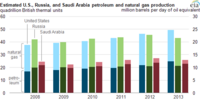U.S. First In Oil Production - Gas Prices Still High - "Drill Baby Drill Will Lower Fuel Cost" Is A Big Oil Lie
 U.S. Drivers |
EDITOR'S NOTE: When is the last time you heard a Big Oil sycophant pronounce "Drill Baby Drill". Well we did drill and we fracked and in 2013 sucked the most oil out of "our" land ever, yet gas prices are still at historic highs...but oh yes we are exporting gasoline now, see the below editorial, Who's Supply, Who's Demand? Time to get pissed America, Time to get real Pissed. We believe that all of the "drill baby drill" rhetoric has further delayed America's demand for the elimination of "regular gasoline" and its replacement by High Test E85,, when this happens American's reliance on imported oil will drop to 0, what a nice thought. .
SEE ALSO: MPG Hysteria Will Go Away, When American Drivers Use Non-Exportable Domestic Fuel
SEE ALSO: Who's Supply, Who's Demand? World Petroleum Use Sets Record High In 2012, American Driver Pay More
Washington DC October 3, 2013; The U.S. Energy Information Administration estimates that the United States will be the world's top producer of petroleum and natural gas hydrocarbons in 2013, surpassing Russia and Saudi Arabia. For the United States and Russia, total petroleum and natural gas hydrocarbon production, in energy content terms, is almost evenly split between petroleum and natural gas. Saudi Arabia's production, on the other hand, heavily favors petroleum.
Since 2008, U.S. petroleum production has increased 7 quadrillion Btu, with dramatic growth in Texas and North Dakota. Natural gas production has increased by 3 quadrillion Btu over the same period, with much of this growth coming from the eastern United States. Russia and Saudi Arabia each increased their combined hydrocarbon output by about 1 quadrillion Btu over the past five years.
Comparisons of petroleum and natural gas production across countries are not always easy. Differences in energy content of crude oil, condensates, and natural gas produced throughout these countries make accurate conversions difficult. There are also questions regarding the inclusion of biofuels and refinery gain in the calculations. Total petroleum and natural gas hydrocarbon production estimates for the United States and Russia for 2011 and 2012 were roughly equivalent—within 1 quadrillion Btu of one another. In 2013, however, the production estimates widen out, with the United States expected to outproduce Russia by 5 quadrillion Btu.
Principal contributors: Hannah Breul, Linda Doman



